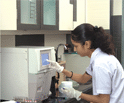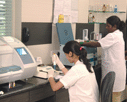Allergic Diseases in India
- Allergic diseases like bronchial asthma, allergic rhinitis, atopic dermatitis are increasing dramatically.
- Major causative agents implicated are pollens, fungal spores, dust mites,animal epithelia etc.
- Upto 30% of all visits to general practitioners & pediatric specialists are due to allergic symptoms.
- Lack of awareness forces people to deal with the problem symptomatically.
- Allergic diseases, if not detected early can lead to severe consequences.
ROLE OF ALLERGY IN VARIOUS DISEASES
- Eczema &Urticaria
- Asthma
- Drug reaction
- Food reaction
- Rhinitis
COMMON ALLERGIES
Allergic diseases may invove any part of the body. The most frequently involved are the nose & chest with resultant symptoms of hay fever, asthma or rhinitis. Anaphylactic shock is very severe affecting many organs at the same time, causing rapid decrease in blood pressure, fainting & occasionally death. Some common types are:
- Mold allergy
- Food allergy
- Drug allergy
- Insect allergy
- Pollen allergy
- Occupational allergy
ALLERGIC MANIFESTATIONS
| Target Area | Symptoms |
|---|---|
| Nose | Nasal itching, congestion, sneezing, post – nasal drip, watery discharge |
| Eyes | Itching, redness, swelling, tearing & other conjunctivitis symptoms |
| Ears | Fluid in middle ear, recurrent infection |
| Lungs | Asthmatic symptoms such as shortness of breath, wheezing, chest tightness, coughing etc. |
| Skin (lips, inside of mouth, ears) | Itchy welts or “hives” (urticaria) of varying sizes |
| Skin (contact dermatitis) | Blistery rash, intense itching |
| Skin (eczema) | Dry, itchy rash |
| Digestive tract | Stomach cramps, vomiting, diarrhea |
ALLERGY DIAGNOSIS:
The clinician’s investigation of the allergic patient has 2 components:
- Evaluation of the patient’s environment.
- Evaluation of the patient’s immunological response to allergens.
Once the triggers are identified, the treatment strategies can be formulated. Before any therapy is instituted, the suspected allergens must be identified.
Along with clinical findings, laboratory diagnosis of allergy is very important to get a clear picture of causative agent, treatment & patient management. The tests can be:
- In – vivo: this assesses the symptomatic response of the patient towards suspected allergens in-vivo. The patients are subjected to controlled exposure of the suspected allergens & checked for response. Albeit it’s utility, the test limitations.
- In- vitro diagnosis: in – vitro diagnosis of allergy has enabled allergy testing to be performed from a single blood sample. The test quantitatively measures Ig E that is specific to particular allergens. Tests involved in this diagnosis are:
- Total Ig E: this test estimates the level of total serum Ig E. the serum Ig E level gives an indication of the degree of sensitization to the allergen. A raised level indicates the patient is probably allergic, though some other conditions are also cause the level to go up.
- Specific Ig E: this is a more relevant test, as it identifies the causative allergen & the concentration of specific antibody elicited against the causative allergen.
The plethora of allergens makes it difficult to test for all of them. Panel based tests against specific groups of allergens such as respiratory, food , etc. can be done with only a single serum sample. These are very simple & does not require any special patient preparation. In – vitro specific allergy testing has been gaining acceptance due to its applicability, utility & rapidity. These tests also correlate with other testing methodologies for allergy diagnosis.
WHEN TO ASK FOR SPECIFIC Ig E TESTING
- Diagnosing allergies.
- Diagnosing atopies.
- Extended investigation of allergies parallel to screening for specific Ig E as a part of differential diagnosis from parasitic disorders.
- Illness associated with eosinophilia or fever of unknown origin ( drug related fever).
- To rule out broncho – pulmonary aspergillosis.
- Diagnosis of IgE myeloma.
- Extended investigation of allergies in case of eosinophilic pulmonary infiltration, allergic alveolitis.
IN- VITRO SPECIFIC Ig E TESTING : Indications
- In patients with severe dermatographism , ichthyosis or generalized eczema.
- For patients who have been receiving long active histamines, tricyclic anti – depressants or medications that may put the patient at undue risk if they are discontinued.
- Evaluation of cross reactivity between insect venoms.
- Adjunctive laboratory test for disease activity of allergic broncho – pulmonary aspergillosis & certain parasitic diseases.
- Clinical history suggests a greater risk of anaphylaxis from skin testing.
- Pediatric patients who are not suitable for other tests.
- Pediatric patients who are not suitable for other tests.





 Shreeji Pathlab is equipped with the latest hi-tech instruments for giving our patients the best.
Shreeji Pathlab is equipped with the latest hi-tech instruments for giving our patients the best.  The laboratory has provided various body profile
checkups like executive profile, cardiac profile, liver
profile, kidney
The laboratory has provided various body profile
checkups like executive profile, cardiac profile, liver
profile, kidney